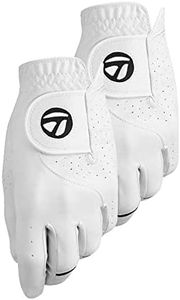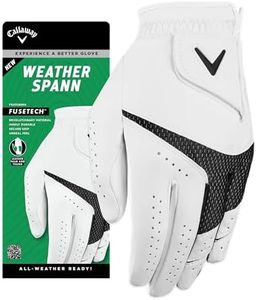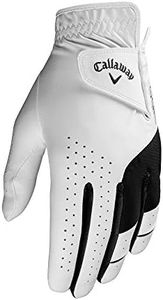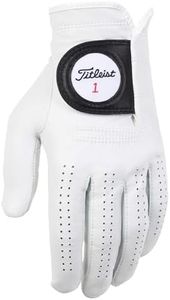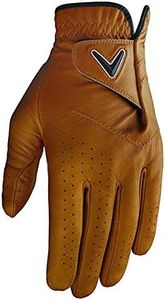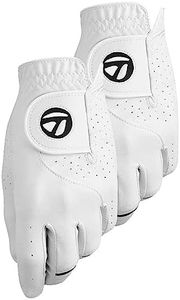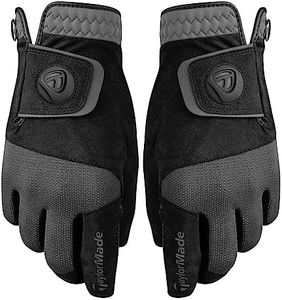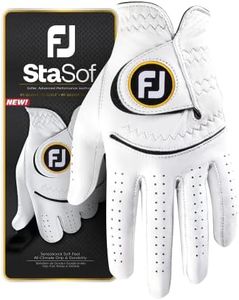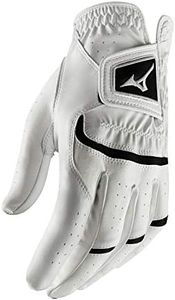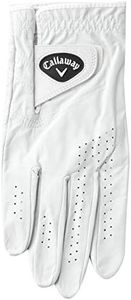We Use CookiesWe use cookies to enhance the security, performance,
functionality and for analytical and promotional activities. By continuing to browse this site you
are agreeing to our privacy policy
10 Best Golf Gloves
From leading brands and best sellers available on the web.Buying Guide for the Best Golf Gloves
Selecting the right golf gloves can make a noticeable difference in your comfort, grip, and overall game performance. While all golf gloves might look similar, they actually present subtle variations in fit, material, and features to suit different players' preferences, playing conditions, and hand shapes. Your choice should focus on how well the glove feels on your hand, how it responds in different weather situations, and how it supports your grip throughout a round. By knowing what features matter and how those features align with your needs, you can choose a glove that enhances both your confidence and your control on the course.MaterialThe material of a golf glove affects comfort, durability, breathability, and grip. Common materials include leather, synthetic, and combination (hybrid) gloves. Leather gloves are generally softer and provide an excellent natural feel and grip, especially good for dry conditions, but may wear more quickly. Synthetic gloves are usually more affordable, last longer, and handle wet conditions better but sometimes lack the premium feel of leather. Hybrid gloves combine both features, offering leather in the palm for grip and synthetic materials elsewhere for durability and flexibility. To decide, think about where and how often you play: those playing mostly in dry weather may prefer the superior feel of leather, while those expecting rain or high humidity may lean toward synthetic or hybrid gloves.
Fit/SizingThe fit of a golf glove is crucial for performance because a glove that's too loose will slip, while one that's too tight can restrict movement and cause discomfort. Sizing varies by brand but generally includes small, medium, large, extra-large and sometimes cadet sizes (which are shorter in the fingers but wider in the palm). A glove should fit like a second skin; there shouldn’t be excess material at the fingertips or in the palm. When fitting, look for a snug yet comfortable feel and make a fist to see if your movements are unrestricted. If you have shorter fingers or wider palms, cadet sizing may offer a better option.
Grip and Palm DesignGrip is determined by the texture and design of the glove’s palm area. Some gloves have textured or patterned reinforcements to help you maintain a firm hold on the club, especially in wet or sweaty conditions. A more aggressively textured palm offers added security but may slightly reduce the level of soft touch. Consider your tendency to lose grip or sweat in your hands, and if that’s the case, look for gloves specifically designed to enhance traction even when damp.
Weather AdaptabilityDifferent gloves are designed for specific weather conditions, such as standard gloves for everyday play, rain gloves for wet weather, and thermal gloves for colder temperatures. Rain gloves typically become grippier as they get wet, while thermal gloves offer insulation but might be less tactile. Think about the climate in which you play most often: if you often face rain or cold, it’s worth having a glove designed for those conditions to ensure optimal performance and comfort.
Breathability and VentilationBreathability refers to how well the glove lets air pass through, which is important for comfort and reducing sweat buildup. Gloves with perforations, mesh panels, or moisture-wicking technologies help keep your hand dry and cool. If you tend to play in hot, humid environments or have sweaty hands, prioritize a glove that mentions breathability or ventilated design to minimize discomfort and slippage.
DurabilityDurability is how long the glove maintains its structure, grip, and comfort before wearing out. Gloves made primarily of synthetic materials are typically more durable, but even leather gloves often reinforce high-wear areas. If you play frequently or need your gear to last longer, lean toward designs with reinforced stress points or those marketed for durability. For occasional or casual play, the highest durability may not be as pressing a concern.
Closure TypeThe closure type, usually a Velcro strap, affects how securely the glove stays on your hand and how easily you can adjust it. While most gloves use Velcro for its simplicity and adjustability, some may offer alternative mechanisms for a more customized fit. Ensure that the closure allows you to fine-tune the fit around your wrist for a balance between security and comfort, especially if you find gloves slipping or feeling loose during play.

